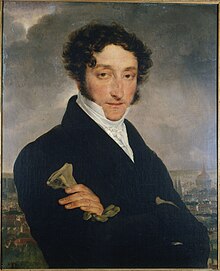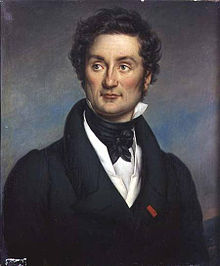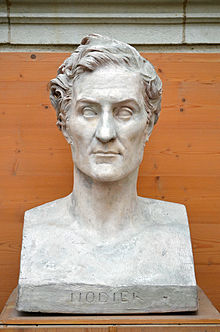Charles Nodier
Charles Nodier | |
|---|---|
 Portrait formerly thought to be of Charles Nodier (date and artist unknown) | |
| Born | Jean Charles Emmanuel Nodier 29 April 1780 Besançon,Franche-Comté,France |
| Died | 27 January 1844(aged 63) Paris, France |
| Occupation(s) | Writer Librarian |
| Years active | 1802–1844 |
Jean Charles Emmanuel Nodier(29 April 1780 – 27 January 1844) was a French author and librarian who introduced a younger generation ofRomanticiststo theconte fantastique,gothic literature,andvampiretales. His dream related writings influenced the later works ofGérard de Nerval.

Early years[edit]
He was born atBesançonin France, near the border with Switzerland. His father, on the outbreak of theFrench Revolution,was appointed mayor of Besançon and consequently chief police magistrate, and seems to have become an instrument of the tyranny of theJacobinswithout sharing their principles. But his son was for a time an ardent citizen, and is said to have been aJacobin Clubmember at the age of twelve.[citation needed]In 1793 Charles saved the life of a lady guilty of sending money to anémigré,declaring to his father that if she were condemned he would take his own life.[citation needed]He was sent toStrasbourg,where he studied withEulogius Schneider,the notorious Jacobin and public prosecutor ofAlsace,but a goodGreekscholar.[1]
Activism and wanderings[edit]
During theReign of Terrorhis father put him under the care ofJustin Girod-Chantrans,with whom he studied English and German. His love of books began very early, and he combined with it a strong interest in nature, which Girod-Chantrans was able to foster. He became librarian in his native town, but his exertions in the cause of suspected persons brought him under suspicion. An inspection of his papers by the police, however, revealed nothing more dangerous than a dissertation on the antennae of insects.Entomologycontinued to be a favourite study with him, but he varied it withphilologyand pure literature and even political writing. For a skit onNapoleon,in 1803, he was imprisoned for some months.
He then left Paris, where he had gone after losing his position at Besançon, and for some years lived a very unsettled life at Besançon,Dole,and in other places in the Jura. During these wanderings he wrote his novel,Le peintre de Salzbourg, journal des émotions d'un coeur souffrant, suivi des Meditations du cloître[2](1803). The hero, Charles, who is a variation of theWerthertype, desires the restoration of the monasteries, to afford a refuge from the woes of the world. At Dole, on 31 August 1808, he married Désirée Charve. Their only daughterMarie-Antoinette-Élisabeth Mennessier-Nodier(1811 – 1893) became a noted woman of letters. Nodier was working as a secretary to the elderlySir Herbert Croft, 5th Baronetand his platonic friendLady Mary Hamilton.During this time he translated Hamilton's bookMunster Villageand helped her writeLa famille du duc de PopoliorThe Duc de Popoliwhich was published in 1810.[3]
In December 1812 Nodier moved toLjubljana,then the capital of the newly established FrenchIllyrian Provinces,and was in 1813 the last editor of a multilingual newspaper, theOfficial Telegraph of the Illyrian Provinces(Télégraphe officiel des Provinces Illyriennes) published in French, German and Italian.[4]It was there that Nodier composed, in 1812, the first draft of his novelJean Sbogar.[5]The story about a love between abrigandand a daughter of a rich merchant was finally published in 1818.[6]After the evacuation of French forces from theIllyrian provincesin 1813 he returned to Paris, and the Restauration found him a royalist, though he retained something of republican sentiment. In 1824 he was appointed librarian of theBibliothèque de l'Arsenal,a position that he kept for the rest of his life. He was elected a member of theAcadémie françaisein 1833, also of theSociété Entomologique de Francewhen this was formed in 1832, and he was made a member of theLegion of Honour.[7]He died, aged, 63, in Paris.
The twenty years at the Arsenal were the most important and fruitful of Nodier's career. He had the advantage of a settled home in which to collect and study rare and unusual books; and he was able to establish a celebrated literary salon, known as LeCénacle,rallying a knot of young literary men to romanticism (the so-calledRomanticistsof 1830), some of whom would achieve great renown themselves.Victor Hugo,Alfred de MussetandSainte-Beuveall acknowledged their obligations to him, andAlexandre Dumasincorporated his recollections of Nodier into his noveletteLa Dame au Collier de Velours.The group includedAlphonse de Lamartine,Gérard de Nerval,andLouise Crombach.[8]Nodier was a passionate admirer ofGoethe,Laurence SterneandShakespeare,and himself contributed to the literature that was one of the leading traits of the Romantic school.
Works[edit]

His best and most characteristic work, which is exquisite in its kind, consists partly of short tales of a more or less fantastic character, partly of nondescript articles, half bibliographic, half narrative, the nearest analogue to which in English is to be found in some of the papers ofThomas De Quincey.The best examples of the latter are to be found in the volume entitledMélanges tirés d'une petite bibliothèque,published in 1829 and afterwards continued. Of his tales the best areInfernaliana(1822);Smarra, ou les démons de la nuit(1821);Trilby, ou le lutin d'Argail(1822);Histoire du roi de Bohême et de ses sept châteaux(1830);La Fée aux miettes(1832);Inès de las Sierras(1837);Les quatre talismans et la légende de soeur Béatrix(1838),[9]together with some fairy stories published in the year of his death, andFranciscus Columna,which appeared after it. TheSouvenirs de jeunesse(1832) are interesting but untrustworthy[citation needed],and theDictionnaire universel de la langue française(1823), which, in the days beforeLittré,was one of the most useful of its kind, is said to have been not wholly or mainly Nodier's[citation needed].There was a so-called collection ofŒuvres complêtespublished in 12 vols. in 1832, but at that time much of the author's best work had not yet appeared, and it included but a part of what was previously published. Nodier found an indulgent biographer inProsper Mériméeon the occasion of the younger man's admission to the academy.
During the 1820s, after adapting Dr.John William Polidori's short story "The Vampyre"successfully for the stage in France (Le Vampire,1820), Nodier involved himself in the theatre for a few years. Among these works wereBertram ou le Pirate(1822), based on a play byCharles Maturinin England (Bertam, or The Castle of St. Aldobrand), andLe Monstre et le Magicien(1826), which adapted an English play based on Mary Shelley's novelFrankenstein.Nodier also translated and adapted an Italian play by Carmillo Frederici (Le Delateur-The Informer) in 1821. Despite the success of these works, he lost interest in the theatre, and by the late eighteen twenties devoted himself entirely to literature, mostly to the conte fantastique.
An account of his share in the Romantic movement is to be found inGeorg Brandes'sMain Currents in Nineteenth Century Literature.Nodier'sDescription raisonnée d'une jolie collection de livres(1844), which is a catalogue of the books in his library, contains a life byFrancis Weyand a complete bibliography of his numerous works. See also Sainte-Beuve,Portraits littéraires,vol. ii.; Prosper Mérimée,Portraits historiques et littéraires(1874); and A Estignard,Correspondance inédite de Charles Nodier, 1796–1844(1876), containing his letters to his childhood friend and fellow enthusiast in literature, Charles Weiss.
A collection of Nodier's dream writings (De Quelques Phénomènes Du Sommeil) was published by Le Castor Astral in 1996.
Musical adaptations of Nodier'sTrilby[edit]
Nodier's 1822 novellaTrilby, ou le lutin d'Argail,provided the inspiration for the balletLa Sylphide,1832, to a scenario devised byAdolphe Nourrit.In 1870, the novella was adapted for another ballet titledTrilbyby the great choreographerMarius Petipa,balletmaster of theTsar'sImperial BalletofSt. Petersburg, Russia.
ThelibrettoofJohn Barnett's 1834 operaThe Mountain Sylphis also adapted fromTrilby,via the balletLa Sylphide.
Commemoration[edit]

There are streets in France named after Charles Nodier, located inMontmartreParis,Pantin,ReimsandBesançon.
The centre of French science and culture inLjubljana,established in December 1966, was in 1983 named theCharles Nodier French Cultural Centre(now the Charles Nodier French Institute). It is housed on the left bank of theLjubljanica,between thePrešeren Squareand theSt. James' Bridge.From 1994 to 2008, the institute regularly published a bulletin titledLe Petit Nodier.Since 1985, a bronze bust of Nodier stands at the court of its building, work ofJakov Brdar,according to the plans by the architectMarjan Ocvirk.It is a vivid portrait with a sharp look and some traces of theSecessionstyle.
Selected works[edit]
Fiction and creative writings[edit]
- Stella, ou Les Proscrits(1802) – (Stella or The Exiles) – a juvenile novel which was subsequently abandoned by the author in his several collected works.
- Le Dernier Chapitre de Mon Roman(1803) – (The Last Chapter of My Novel) – a short novel.
- Le Peintre de Salzbourg, Journal des Émotions d'un Cœur Souffrant(1803) – (The Painter of Salzbourg, Journal of a Suffering Heart) – a novel.
- Les Tristes, ou mélanges tirés des tablettes d'un suicidé(1806) – a collection of death-haunted romantic writings which includes Nodier's first conte fantastique, "Un Heure, ou la Vision"; and the poetic essay "Les Méditations du Cloître", which was inspired byChateaubriand.
- Le Chant des Morlaques(1814) – (The Song of theMorlachs) – a short poetic essay that has been included in a collection of Nodier's dream writings.
- Contes fantastiques(1814) – a fantasy short stories collection.
- Jean Sbogar, Histoire d'un Bandit Illyrien Mysterious(1818) – a full-length novel. A gothic political romance mostly set inIllyria.
- Thérèse Aubert, Roman d'Amour Pendant les Guerres Vendéennes(1819) – a love story set in the wake of theFrench Revolution,it is in the form of a novella.
- Le Vampire(1820) – (The Vampire) – an atmospheric full-length theatrical play, freely adapting the story ofJohn William Polidori.
- Adèle(1820) – written in the form of letters, a love story of novella length.
- Smarra, ou les Démons de la Nuit, conte fantastique(1821) – the author's most celebrated work, a remarkable novella, one of his dream writings, which features a vampire. The word "Smarra" was taken from the Dalmatian word for "Nightmare".
- Trilby, ou le Lutin d'Argail, conte fantastique(1822) – one of Nodier's best known works, an atmospheric adult fairy tale of novella length set in a Scottish landscape.
- Infernaliana(1822) – a book of little tales of ghosts and vampires, some of which were culled from earlier sources.
- Le Songe d'Or, ou Arlequin et l'Avare, Pantomime Anglais en 11 Tablaux(1828) – a pantomime for the theatre which was subsequently adapted into a short story in 1832.
- Mélanges tirés d'une petite bibliothèque(Paris: Crapelet, 1829)
- Histoire du Roi de Bohême et de ses Sept Châteaux(1830) – an experimental full-length novel.
- De Quelques Phénomènes du Sommeil(1831) – (Of Some Phenomena of Sleep) – a short journalist piece, one of Nodier's dream writings, also published under the titleLe Pays des Rêves.
- M.de la Mettrie,ou les Superstitions(1831) – a short story which has been included in a collection of Nodier's dream writings.
- Souvenirs de Jeunesse(1832) – (Souvenirs of Youth) – a collection of novellas comprising "Séraphine", "Clémentine", "Amélie", and "Lucréce et Jeannette". Subsequent editions included "Thérèse". Dedicated toAlphonse de Lamartine.
- La Fée aux Miettes, conte fantastique(1832) – (The Crumb Fairy) – a full-length novel. A satirical adult fairy tale set in Scotland, it is one Nodier's most celebrated works.
- Mademoiselle de Marsan, conte fantastique(1832) – a gothic short novel.
- Jean-François les Bas-Bleus(1832) – a short story.
- Le Dessin de Piranèse(1833) – a descriptive essay that develops into one of Nodier's dream writings. A shorter version was published asPiranèsein 1836.
- Hurlubleu(1833) – a novella.
- La Combe de l'Homme Mort(1833) – a short weird horror story.
- Trésors des Fèves et Fleurs des Pois(1833) – a short story.
- M.Cazotte(1834) – a short story.
- Des Hallucinations et des Songes en Matière Criminal(1835) – an essay which has been included in a collection of the author's dream writings.
- Paul ou le Resemblance(1836) – a short story.
- Inès de Las Sierras(1837) – a gothic novella set in a nocturnal storm.Alexandre Dumascomplained to the author about the rationalization of this story in an addendum at its end, and Nodier conceded the point. This is recorded in Dumas' novellaLa Femme au Collier de Velours,which begins with a personal portrait and some reminiscences of Nodier and the Cėnacle.
- Les Quatre Talismans, et La Légende de Sœur Beatrix(1838) – two 'contes fantastiques,' a short novel and a short novella, the latter composed of Christian imagery.
- La Neuvaine de la Chandeleur, et Lydie(1839) – a novella and a short story.
- Franciscus Columna(1844) – a novella.
Some non-fiction works[edit]
- Dissertation sur l'Usage des Antennes dans les Insectes(1798) – (A Dissertation on the Use of Antennae in Insects).
- Pensées de Shakespeare Extraites de ses Ouvrages(1800) – (Thoughts of Shakespeare Taken from his Works) – a short essay.
- Bibliographie Entomologique(1801) – (Entomological Bibliography).
- Dictionnaire Raisonné des Onomatopées Françaises(1808) – (Reasoned Dictionary of French Onomatopoeia) – a dictionary of words derived from the sound associated with the subject (e.g. Cuckoo). A high point of the author's early years which was somewhat expanded in a new edition of the book in 1828.
- Questions de Littérature Légale(1812)
- Histoire des sociétés secrètes de l'armée: et des conspirations militaires qui ont eu pour objet la déstruction du gouvernement de Bonaparte.Paris: Gide fils, 1815. (Eds.) Nodier, Bazin, Didier, Lemare, Lombard; English trans. (2008) Cornerstone Book Publishers.
- Promenade de Dieppe aux Montagnes de l'Écosse(1821) – a book describing Nodier's travels through Britain including Scotland. His experience of the Scottish landscape inspired two of his best known works:TrilbyandLa Fée aux Miettes,which were set in Scotland.
- Essai sur le Gaz Hydrogène et les Divers Modes d'Éclairage Artificiel(1823) – (An Essay on Hydrogen Gas and the Various Methods of Artificial Lighting).
- Dictionnaire Universal de la Langue Française(1823) – (Universal Dictionary of the French Language).
- Mélanges Tirés d'une Petite Bibliothèque(1829)
- Du Fantastique en Littérature(1830) – a full-length study of the weird or fantastic in literature.
- Bibliographie des Fous: De Quelques Livres Excentriques(1835) – (Bibliography of the Mad: Of Some Eccentric Books).
- La Seine et ses Bords(1836–1837) – (The Seine and its banks) – a full-length description of the river and the geography of its banks. Illustrated by Marville and Foussereau.
- Description Raisonnée d'une Jolie Collection de Livres(1844) – (Reasoned Description of a Beautiful Collection of Books).
A contested novel[edit]
- Lord Ruthwen, ou Les Vampires(1820) – a rambling vampire novel based on earlier sources, a description of which is given at the end of the book. The overall theme is in the form of a sequel to Dr.John William Polidori's short story "The Vampyre",and the material suggests that it may originally have been intended as a play. The title page of the first edition attributed publishing to the author ofJean Sbogarand authorship to the pseudonym "C. B.", causing historians to speculate that the book was written by a contemporary vaudeville manager named Cyprien Bérard, with whom Nodier was associated. The sources for the stories suggest the knowledge of a librarian and a bibliophile, and the novel misspells the name Ruthven as occurred in the text ofPromenade de Dieppe aux Montagnes de l'Écosse.There are features of Nodier'sJean SbogarandLes Tristesin the novel, but the writing is hurried and lacks the quality of Nodier's other fictional works.
References[edit]
- ^Cf. A.R. Oliver (1964).Charles Nodier: Pilot of Romanticism(Syracuse, N.Y.: Syracuse University Press), 13-14.
- ^"The Painter of Salzburg, journal of the emotions of a suffering heart, followed by Meditations on the Cloister".
- ^Dahan, Charles Nodier; édition établie, présentée et annotée par Jacques-Remi (1995).Correspondance de jeunesse.Genève: Droz. p. 331.ISBN2600000690.
{{cite book}}:CS1 maint: multiple names: authors list (link) - ^Juvan, Andreja (2003)."Charles Nodier in Ilirija"[Charles Nodier and Illyria].Kronika: časopis za slovensko krajevno zgodovino(in Slovenian).51(2). Section for the History of Places, Union of Historical Societies of Slovenia: 179.ISSN0023-4923.
- ^"Gallica - Erreur".
- ^"Charles Nodier (1780–1844)".Ilirske Province / Provinces Illyriennes[Illyrian Provinces](PDF)(in Slovenian and French). Government Communication Office, Republic of Slovenia. 9 May 2009. p. 6.
- ^He appears as a chevalier of the Légion d'Honneur on the title page of hisMélanges,1829.
- ^Laurence Dupérier et Christine Planté (2 September 2020)."CROMBACH Louise [CROMBACH Claudine, Augustine, dite Louise] (orthographiée (...)".maitron.fr(published 2009-02-20).Retrieved2021-01-02.
- ^The source for the operaBéatriceby André Messager
- This article incorporates text from a publication now in thepublic domain:Chisholm, Hugh,ed. (1911). "Nodier, Charles".Encyclopædia Britannica.Vol. 19 (11th ed.). Cambridge University Press. p. 731.
Further reading[edit]
- Oliver, A. Richard (1960). “Unpublished Analysis of Some Fine Editions by the Young Bibliophile Charles Nodier.”Library Quarterly30 (April): 140–43.
- Oliver, A. Richard, (1964).Charles Nodier: Pilot of Romanticism(Syracuse, N.Y.: Syracuse University Press)
- Loving, M. (2003). "Charles Nodier: The Romantic Librarian".Libraries & Culture,38(2), 166–188.
- Engel, Manfred, (2008). "Literarische Anthropologie à rebours. Zum poetologischen Innovationspotential des Traumes in der Romantik am Beispiel von Charles NodiersSmarraund Thomas DeQuinceysDream-Fugue".Komparatistik als Humanwissenschaft,ed. Monika Schmitz-Emans, Claudia Schmitt and Christian Winterhalter (Würzburg: Könighausen & Neumann), 107–116.
- Porée, Adolphe-André(1903).Note sur Auguste Le Prévost et Charles Nodier(in French). Rouen: L. Gy.
External links[edit]
- Cahiers d'Études NodiéristesArchived2012-04-26 at theWayback Machine,scholarly journal devoted to Nodier studies (in French).
- "Jean Sbogar, Volume One" (in French)
- "Jean Sbogar, Volume Two" (in French)
- Works by Charles NodieratProject Gutenberg
- Works by Charles NodieratFaded Page(Canada)
- Works by or about Charles NodieratInternet Archive
- Works by Charles NodieratLibriVox(public domain audiobooks)

- "Promenade from Dieppe to the Mountains of Scotland" (In English)
- "Promenade de Dieppe aux Montaignes de l'Ecosse" (In French)
- "Dictionnaire Raisoné des Onomatopées Françaises" (Second edition of 1828, in French)
- "La Fée aux Miettes" (In French)
- 1780 births
- 1844 deaths
- 18th-century French writers
- 18th-century French male writers
- 19th-century French novelists
- 19th-century French poets
- 19th-century French short story writers
- 19th-century French male writers
- Burials at Père Lachaise Cemetery
- French lexicographers
- French fantasy writers
- French monarchists
- French librarians
- French entomologists
- Members of the Académie Française
- Writers from Besançon
- French male novelists
- French male short story writers
- Knights of the Legion of Honour
- French male non-fiction writers
- 19th-century lexicographers
- French bibliophiles
